BIOGRAPHY page 1
Herbert Edgar Wyndham was born to a family of moderate means in London, England around 1910. He demonstrated a mechanical aptitude at a young age, tinkering with bikes and cars to improve their efficiency and performance. No matter how good the machine, however, Herbert realized the operator was forever limited by how well they could control it. To improve the system of man and machine working together, both would need to be improved upon. From this basic insight he developed an increased interest in biology, especially the scientific community’s growing understanding of the genetic code and the possibility of changing the building blocks of life. [Uncanny X-Men Annual #12]
While awaiting news of a possible scholarship to Oxford University, Herbert lived in his mother’s home and converted her basement into his personal laboratory. Herbert designed his own genetic accelerator in an effort to deliberately induce mutation and controlled evolution in living creatures. Although he had some moderate success with affecting his test rats at a cellular level, the process was too traumatic for his subjects to survive the outcome. A consummate scientist, Wyndham kept a detailed record of his experiments and their results, in the hopes that he could find the secrets of life.
Herbert had earned the respect of a Professor Hanley at Oxford while seeking admission and, through him, Wyndham received an invitation to the International Conference on Genetics in Geneva, Switzerland. Herbert had expended his father’s inheritance on the current model genetic  accelerator and felt he could not continue his work without access to greater funds or facilities. He attended the conference, intent on impressing the scientific community with his ideas, securing a scholarship to Oxford, or perhaps even a private sponsor to support his experiments. At the conference, Herbert made the acquaintance of an American zoology student from Yale, Jonathan Drew.
accelerator and felt he could not continue his work without access to greater funds or facilities. He attended the conference, intent on impressing the scientific community with his ideas, securing a scholarship to Oxford, or perhaps even a private sponsor to support his experiments. At the conference, Herbert made the acquaintance of an American zoology student from Yale, Jonathan Drew.
They attempted to bend the ear of the community’s big names like Wladyslav Shinsky and his student, Arnim Zola, but Shinsky would only preach caution and patience. He believed genetics experiments were unethical until the genetic code was properly mapped, else horrific consequences would arise from “rummaging around” in cellular material. Angry and disheartened, Herbert and Jonathan got drunk after the conference to complain about the close-minded intellectuals at the top of their field. While relieving himself in an alleyway, Wyndham was 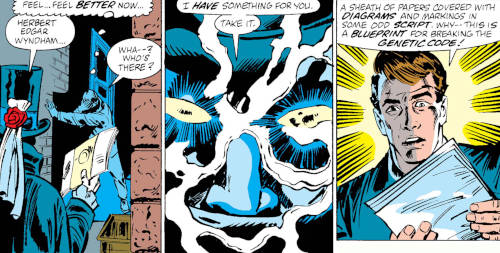 approached by a tall, mysteriously cloaked man who offered him parchments containing genetics information to help his work. With only a cursory glance, Herbert realized the papers described the genetic code far beyond the current understanding of science. [X-Factor Annual #3]
approached by a tall, mysteriously cloaked man who offered him parchments containing genetics information to help his work. With only a cursory glance, Herbert realized the papers described the genetic code far beyond the current understanding of science. [X-Factor Annual #3]
[Note: Quicksilver #9 had an alternate take on this encounter. Wyndham was a graduate student who took time off to travel the world, and met his benefactor in Alexandria, Egypt. His focus of his experiments was also described as a response to World War I, an attempt at creating a race of men who could survive the horrors of war.]
Herbert eventually managed to secure a scholarship and enroll in Oxford. Herbert’s passion for the subject of genetics made him well-liked among some of his professors, such as Nathaniel Essex. [X-Men (2nd series) #99] By 1930, he had spent a year-and-a-half attending classes on biology and genetics, but his real focus was devoted to decoding the script and notations on his prized parchment. However, the department head Professor Reardon saw that Wyndham was focused on his own interests, not on his grades, and he confronted Herbert about his priorities. Herbert had little patience for the banality of academia when true scientific breakthroughs were his to make, but he recognized Oxford had the best facilities possible for his research. Wyndham 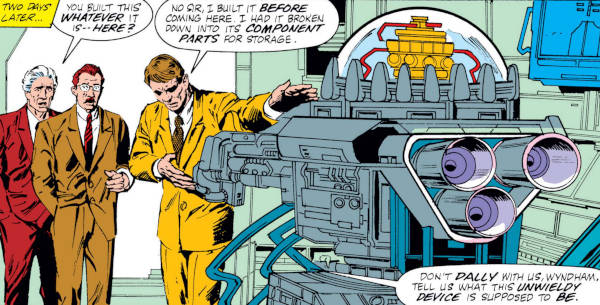 offered to show Reardon and the faculty his private work in the hopes of dazzling them with the implications enough to gain the freedom to determine his own curriculum. At this point, he still only had theories and not proof, though, and the combination of Herbert’s wild ideas and short temper led to him being expelled from Oxford.
offered to show Reardon and the faculty his private work in the hopes of dazzling them with the implications enough to gain the freedom to determine his own curriculum. At this point, he still only had theories and not proof, though, and the combination of Herbert’s wild ideas and short temper led to him being expelled from Oxford.
Back home, Herbert convinced his mother to go live with her sister and rent out the family home to finance his work. With a portion of the parchment translated, Herbert formulated the isotope necessary to narrow and guide the effects of his genetic accelerator. He achieved his first real success mutating the family Dalmatian Dempsey into a humanoid form. Herbert was unprepared for Dempsey’s quick recovery, however, and the man-animal raced out of the laboratory, only to 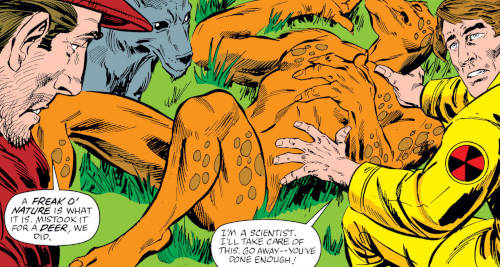 be shot dead by a neighbor. Herbert realized the suburbs of London did not provide the privacy he needed for his work. He reconnected with Jonathan Drew and proposed the idea of pooling resources to build a private research facility for their continued experiments. Jonathan’s wife Miriam had recently inherited a plot of land on Mount Wundagore in Transia, and she was willing to have it renovated if it meant Drew working from home with her and their young daughter, Jessica. Thrilled at the possibilities, Wyndham and Drew packed for the Balkans to build their laboratory. [Thor (1st series) #135, Spider-Woman (1st series) #1, Punisher (2nd series) Annual #1]
be shot dead by a neighbor. Herbert realized the suburbs of London did not provide the privacy he needed for his work. He reconnected with Jonathan Drew and proposed the idea of pooling resources to build a private research facility for their continued experiments. Jonathan’s wife Miriam had recently inherited a plot of land on Mount Wundagore in Transia, and she was willing to have it renovated if it meant Drew working from home with her and their young daughter, Jessica. Thrilled at the possibilities, Wyndham and Drew packed for the Balkans to build their laboratory. [Thor (1st series) #135, Spider-Woman (1st series) #1, Punisher (2nd series) Annual #1]
Luck and fortune followed the scientists in the early days. They discovered uranium on the mountain, enough to finance their work for the foreseeable future once it was properly mined. Their research space expanded further as their neighbor Baron Russoff sold some of his land to the duo as well. With capital in hand, they enlisted the support of Horace Grabsheid, a German engineer and rocket scientist. Horace had ideas for a space-drive engine sufficient to leave the planet entirely, and he was willing to design their “Citadel of Science” in exchange for the money to pursue his own dreams. As was his penchant, Horace designed the Citadel after his own work, so it was possible to make the entire research facility fly if necessary.

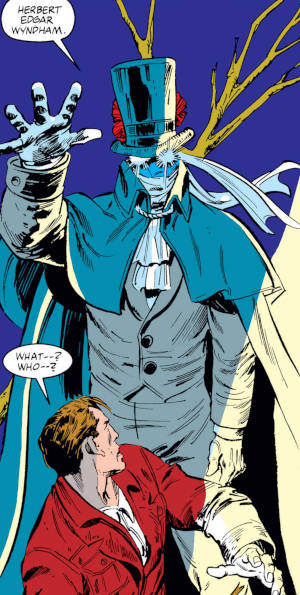 One night, little Jessica saw a figure silhouetted against the moon, and so Wyndham and Drew went searching. Herbert became concerned about security in case word of his mine reached the larger world. As it happened, he was visited again that night by the tall man. Again stating only that he wished to foster scientific advancement, the man offered Herbert assistance in constructing his Citadel of Science. The stranger introduced Herbert to the Moloids, a race of Deviant-spawned sub-humanoids who would serve as near-tireless workers. They could be used to run the uranium mines and build the Citadel to specifications, without having to pay human laborers or worry about their loose tongues. Leaving the Moloids in his care, Herbert’s mysterious benefactor vanished again before he could learn more about the man. [Silver Surfer (3rd series) Annual #1]
One night, little Jessica saw a figure silhouetted against the moon, and so Wyndham and Drew went searching. Herbert became concerned about security in case word of his mine reached the larger world. As it happened, he was visited again that night by the tall man. Again stating only that he wished to foster scientific advancement, the man offered Herbert assistance in constructing his Citadel of Science. The stranger introduced Herbert to the Moloids, a race of Deviant-spawned sub-humanoids who would serve as near-tireless workers. They could be used to run the uranium mines and build the Citadel to specifications, without having to pay human laborers or worry about their loose tongues. Leaving the Moloids in his care, Herbert’s mysterious benefactor vanished again before he could learn more about the man. [Silver Surfer (3rd series) Annual #1]
[Note: Herbert Wyndham’s benefactor was eventually revealed in the Handbooks as Phaeder, Inhuman father of Maelstrom who was exiled from Attilan for his forbidden cloning experiments. His son is half-Deviant, which may explain Phaeder’s knowledge of the Moloids. Also of note, Horace Grabshied fled Nazi Germany after the death of his Jewish wife. Changing his name, he and his son Robert Grayson used Wyndham’s money to build their own rocket, settling on the Eternal colony on Uranus before Bob eventually returned to Earth as Marvel Boy in the 1950’s.]
By early 1931, the Citadel of Science was nearly complete. Wyndham and the Drews had been living in small cottages on the land before this and would soon be able to move into more comfortable habitation. Before the Citadel was finished, however, Jessica developed radiation poisoning after prolonged exposure to the radioactive land. With money from the uranium and further knowledge gleaned from Phaeder’s parchments, Herbert created a cryogenic unit to place Jessica in stasis and slow down her deterioration, but the breakdown of her cells seemed terminal. Jonathan’s work with arthropods had isolated a spider-extract serum which he thought could cure radiation poisoning in stricken individuals. The serum had a month’s incubation time, but Herbert thought he could speed up the catalytic process by subjecting Jessica to his genetic accelerator.
Miriam grieved for her daughter’s plight and hated Jon and Herbert for using her as a test subject in their unproven experiments. Jessica was kept in stasis until results could be seen, and the 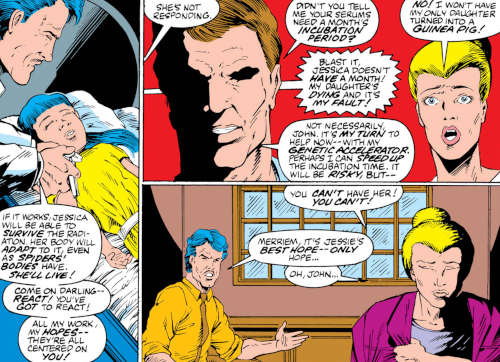 Drews grew apart. [Spider-Woman (1st series) #1] Miriam went missing one night on a walk and was found butchered, the victim of some beast. Drew was already suspicious of the Moloids, and Herbert feared Jon would blame them for his wife’s death. Wyndham obscured the circumstances of Miriam’s demise and told Jon she must have merely stumbled in the dark and hit her head. Wyndham hoped to keep Drew’s mind on their work while he hunted the enigmatic beast on his own. [New Mutants Annual #4]
Drews grew apart. [Spider-Woman (1st series) #1] Miriam went missing one night on a walk and was found butchered, the victim of some beast. Drew was already suspicious of the Moloids, and Herbert feared Jon would blame them for his wife’s death. Wyndham obscured the circumstances of Miriam’s demise and told Jon she must have merely stumbled in the dark and hit her head. Wyndham hoped to keep Drew’s mind on their work while he hunted the enigmatic beast on his own. [New Mutants Annual #4]
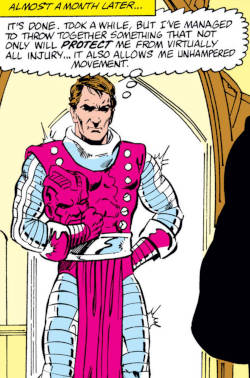 Herbert’s hopes were in vain, as Jonathan grew despondent without his wife and daughter. He could not focus on their efforts and eventually quit their enterprise altogether. Nevertheless, Wyndham continued searching the grounds of the Citadel at night and ran across a genuine werewolf, Miriam’s killer. Shaken by the encounter, Wyndham only survived because the beast fled the coming of sunrise. Not quite ready to believe in supernatural creatures yet, Wyndham still recognized the need to protect himself and designed a suit of armor with silver plating… just in case. Herbert soon had the opportunity to prove his suit worked when the werewolf attacked one of the Moloids. Herbert’s silver-plated armor shielded him from the werewolf and he captured the creature. With the death of one of their own and the work completed, the Moloids vanished into the underground tunnels and were never seen by Herbert again. [Fantastic Four Annual #21]
Herbert’s hopes were in vain, as Jonathan grew despondent without his wife and daughter. He could not focus on their efforts and eventually quit their enterprise altogether. Nevertheless, Wyndham continued searching the grounds of the Citadel at night and ran across a genuine werewolf, Miriam’s killer. Shaken by the encounter, Wyndham only survived because the beast fled the coming of sunrise. Not quite ready to believe in supernatural creatures yet, Wyndham still recognized the need to protect himself and designed a suit of armor with silver plating… just in case. Herbert soon had the opportunity to prove his suit worked when the werewolf attacked one of the Moloids. Herbert’s silver-plated armor shielded him from the werewolf and he captured the creature. With the death of one of their own and the work completed, the Moloids vanished into the underground tunnels and were never seen by Herbert again. [Fantastic Four Annual #21]
As day broke, Herbert discovered his werewolf captive was the neighboring Baron Gregor Russoff. The man was distraught after learning about the killings for which he was responsible and Wyndham offered to cage him on the nights of the full moon while performing his own research into Russoff’s condition. Meanwhile, with the Citadel of Science completed, Herbert could finally return to his own work. The short half-life of his original isotope led Wyndham to 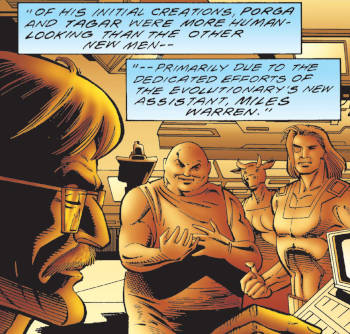 fashion Isotope B as a more stable power source for his genetic accelerator. This proved very effective, and Wyndham carried out successful transformations on a variety of test creatures. These “New Men” included Tagar (the tiger), Porga (the pig), and Bova (the cow), who underwent electronic tutelage to quickly bring them up to modern standards of language, learning, and behavior. [Amazing Spider-Man Annual #22] While Bova was clearly both woman and cow, Tagar and Porga became virtually human in appearance, with only the smallest signs of their animal origins. This success was reportedly achieved with the assistance of Wyndham’s new lab partner and contributor, Miles Warren. [Scarlet Spider Unlimited #1]
fashion Isotope B as a more stable power source for his genetic accelerator. This proved very effective, and Wyndham carried out successful transformations on a variety of test creatures. These “New Men” included Tagar (the tiger), Porga (the pig), and Bova (the cow), who underwent electronic tutelage to quickly bring them up to modern standards of language, learning, and behavior. [Amazing Spider-Man Annual #22] While Bova was clearly both woman and cow, Tagar and Porga became virtually human in appearance, with only the smallest signs of their animal origins. This success was reportedly achieved with the assistance of Wyndham’s new lab partner and contributor, Miles Warren. [Scarlet Spider Unlimited #1]
[Note: Quicksilver #9 claims Bova was the first of the High Evolutionary’s New Men after Dempsey, Scarlet Spider Unlimited #1 indicated she was among the first three, while ASM Annual #22 stated she was twelfth in his successful test subjects.]
